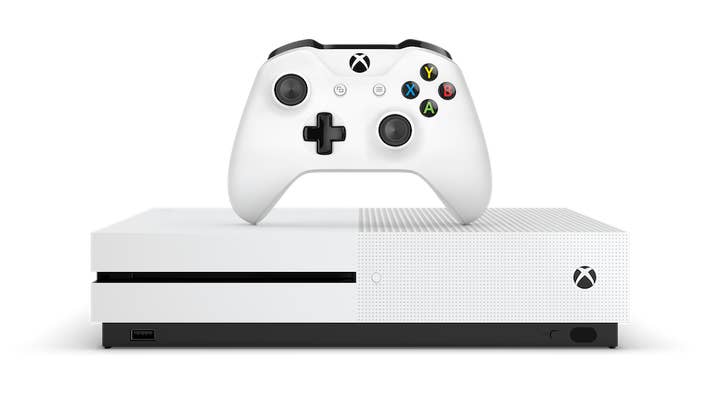Microsoft rolls the dice in a huge Xbox gamble
A slump in Xbox hardware sales is to be expected before the One S arrives, but the company's next results will show whether Scorpio has taken a longer-term toll
Microsoft's latest quarterly results paint a picture of the Xbox' status that's not exactly rosy, but certainly not unexpected. Gaming revenue is down by 9%, with small but reasonable rises in software and services revenue being offset by a one-third collapse in hardware revenue. In the absence of decent hardware sales figures, which Microsoft has declined to release for some years, we can only guess at what exactly that means in unit terms, but it's likely that this past quarter has been one of the toughest for Xbox One hardware since the system launched.
That's unsurprising, of course, when you consider that this is a quarter wedged in between the unveiling of not one but two new Xbox hardware platforms, and the availability of the first of those platforms - the 4K-supporting, heavily redesigned Xbox One S, which will be on shelves in a little under a fortnight. The announcement of redesigned hardware naturally depresses sales of the existing hardware until the launch, partially due to anticipation for the new hardware and also partially due to an expectation that the older model will get a price cut once the new model arrives on the scene.
What makes the figures we can glean from Microsoft's financial results interesting, though, is that they're the first variables we're able to plug into an equation that'll eventually give us our first hard data on the change the console industry is forcing itself through at the moment. Both Microsoft and Sony have now committed to upgrading their hardware mid-cycle. In Sony's case, that comes in the form of a moderate power boost, PS4 Neo, which will have full compatibility with the PS4 enforced firmly by the company. Microsoft, however, is pledged to launch both the redesigned Xbox One S and, more dramatically, the upcoming Scorpio console, which will be an entirely new platform with vastly more processing power than the existing Xbox One.
"The redefinition of Xbox as being a part of a much broader ecosystem of services centred on Windows 10 makes the actual success of Xbox hardware, while not unimportant, certainly less of a priority"
This is unknown territory. We know what happens when you launch mid-cycle refreshes of hardware, of course; those have been a staple of successful consoles since the PlayStation (whose adorably cute miniaturisation, the PSone, remains my personal favourite among all the Sony-designed consoles). A hardware refresh dampens sales of the old version, then sees all those "lost" sales picked up at once in a big spike once the new version launches. Overall, a new hardware launch should deliver stronger sales across the launch quarter (with its major spike) and the pre-launch quarter (with its anticipatory slump) than would have been seen over two normal quarters.
What we don't know, and won't know until we have more data, is what on earth consumers will make of being told of a complete hardware refresh coming down the line far sooner than expected, right at the same time that a more normal hardware refresh is being announced. Scorpio changes everything - or perhaps it changes nothing. We won't know for sure until we can put next quarter's results into the equation alongside this quarter's, and see whether the decline in Xbox sales is down to ordinary anticipation for Xbox One S - or a much more long-term strategising by consumers who see Scorpio as a reason to hold off on the existing generation of Xbox One hardware entirely.
Ordinarily, the risk of the latter event would have been enough to prevent Microsoft from even dreaming of announcing Scorpio this year, let alone announcing it alongside a console redesign it would quite like consumers to buy. This is no ordinary generation, though, and especially not for Microsoft, whose Xbox division finds itself dramatically redefining what it does, how it's positioned within the company and how it measures its success, even as it also fights a thus-far losing battle with Sony in the consumer marketplace. The redefinition of Xbox as being a part of a much broader ecosystem of services centred on Windows 10 makes the actual success of Xbox hardware, while not unimportant, certainly less of a priority than it used to be, and allows the company to take a short-term risk with Xbox One S sales in the name of building long-term credibility by placing Scorpio on the horizon, looming over competitors' plans.
This is not to say Xbox One S won't show a sales spike next month - it's an appealing piece of hardware (as someone who hasn't got an Xbox One yet, I certainly want one) and will find an audience, so I'd be stunned if it doesn't enjoy healthy sales in its introduction month. The question will be how that sales spike compares to the 33% revenue slump seen in the previous quarter, and how ongoing sales after the spike recedes compare. If Xbox hardware doesn't make up that ground, the outcome of Microsoft's gamble will be clear; it will have sacrificed consumer faith in its current generation of hardware in the hope of building anticipation for the much more distant Scorpio.
The company may well be satisfied enough with that outcome, though having its cake and eating it would undoubtedly be preferable. It's telling that the other figure Microsoft provides in its results as a metric for Xbox' performance is "active Live users", which it reports are up by a third year-on-year. "Active Live users" is an interesting statistic, because in many ways it's a reflection of the changing priorities of the division. While Sony's PlayStation Plus numbers may seem like a directly comparable metric, they're not; PlayStation Plus is a service that only has a paid-for tier (so when Sony reports PS Plus numbers, that directly means "people paying us subscription revenue") and is a service that only works on Sony's consoles (so it can also be interpreted as a kind of tie ratio for the consoles).
"Knowing that Xbox Live has 49 million MAUs is all well and good, but without further detail breaking down that number, it's worthless for making business decisions or forecasts around the service on the Windows 10 platform"
Xbox Live is a more complex and nuanced beast, at least in terms of this metric. Although Microsoft pushes the benefits of paid Gold membership hard (and has undoubtedly built up its subscriptions significantly thanks to the major improvements made to Games With Gold), Xbox Live still has a free tier whose members still count towards the monthly active users (MAU) figures being reported. Moreover, Xbox Live is no longer necessarily tied to an Xbox console. It's also a feature of Windows 10, and the company is pushing hard to get more games on Windows 10 to support Xbox Live social features. That means Xbox Live MAU figures don't necessarily reflect subscription revenue, and can't be interpreted as a ratio of Xbox console sales.
The slightly frustrating thing, from an industry perspective, is that this means some genuinely valuable data is being locked up behind that not-terribly-meaningful year-on-year MAU figure. Microsoft is pursuing a number of interesting initiatives with Xbox Live, with the Windows 10 integration being perhaps the most interesting and impactful; but without visibility of any figures on how that integration is proceeding, it's difficult to say whether it's actually making any headway on that platform. Knowing that Xbox Live has 49 million MAUs is all well and good, but without further detail breaking down that number, it's worthless for making business decisions or forecasts around the service on the Windows 10 platform.
The integration of all those numbers isn't just obfuscation on Microsoft's part; it's genuinely an expression, I think, of the company's beliefs about Xbox Live becoming a unifying service between all of its platforms. The firm sees Xbox One and the upcoming Scorpio as merely parts of a family that also includes Windows 10 PCs, Surface tablets and other devices, with Xbox Live as a common bridge between all of them. That's a great vision, and it explains a lot about the company's willingness to make moves that look almost self-sabotaging in the context of its direct market share battle with Sony; but a little more detail about how that vision is progressing and whether it's really taking root across the ecosystem wouldn't go amiss.









